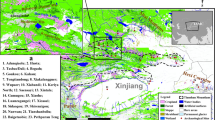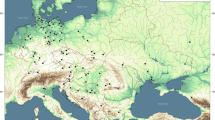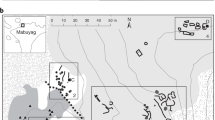Abstract
SORGHUM and millets are among the world's most important food crops and, for the inhabitants of the semi-arid tropics, they are the main sources of protein and energy. Little is known about the history of these crops; their domestication is thought to have occurred in the African savannah, but the date and precise location are unknown1,2. Excavations at an early Holocene archaeological site in southernmost Egypt, 100 km west of Abu Simbel, have yielded hundreds of carbonized seeds of sorghum and millets, with consistent radiocarbon dates of 8,000 years before present (BP), thus providing the earliest evidence for the use of these plants. They are morphologically wild, but the lipid fraction of the sorghum grains shows a closer relationship to domesticated than to wild varieties. Whatever their domestic status, the use of these plants 8,000 years ago suggests that the African plant-food complex developed independently of the Levantine wheat and barley complex.
This is a preview of subscription content, access via your institution
Access options
Subscribe to this journal
Receive 51 print issues and online access
$199.00 per year
only $3.90 per issue
Buy this article
- Purchase on Springer Link
- Instant access to full article PDF
Prices may be subject to local taxes which are calculated during checkout
Similar content being viewed by others
References
Harlan, J. R. Crops and Man (Am. Soc. Agronomy, Crop. Sci. Soc. of Am., Madison, 1975).
Harlan, J. R., De Wet, J. M. J. & Stemler, A. B. L. in Origins of African Plant Domestication (eds Harlan, J. R., De Wet, J. M. J. & Stemler, A. B. L.) 3–19 (Mouton, The Hague, 1976).
Harlan, J. R. Sahara 2, 69–74 (1989).
Harlan, J. R. in Foraging and Farming: the Evolution of Plant Exploitation (eds Harris, D. R. & Hillman, G. C.) 79–98 (Unwin Hyman, London, 1989).
Wasylikowa, K. et al. in Food, Metal and Towns in African Archaeology (eds Ucko, P. & Shaw, T.) (Routledge, London, in the press).
Chevalier, A. Mém. Soc. Biogéog. 6, 307–322 (1938).
Vignier, P. Revue Int. Bot. appl. Agric. trop. 25, 163–230 (1945).
Murdock, G. P. Africa: its Peoples and Their Cultural History (McGraw-Hill, New York, 1959).
Hassan, F. A. J. Wld Prehist. 2, 135–185 (1988).
Bar-Yosef, O. & Belfer-Cohen, A. J. J. Wld Prehist. 3, 447–498 (1989).
Moore, A. M. T. Adv. Wld Archaeol. 4, 1–69 (1985).
Stuiver, M. & Polach, H. A. Radiocarbon 19, 355–363 (1977).
Hedges, R. E. M., Law, I. A., Bronk, C. R. & Housley, R. A. Archaeometry 31, 99–113 (1989).
Bronk, C. R. & Hedges, R. E. M. Nucl. Instrum. Meth. B29, 45 (1987).
Author information
Authors and Affiliations
Rights and permissions
About this article
Cite this article
Wendorf, F., Close, A., Schild, R. et al. Saharan exploitation of plants 8,000 years BP. Nature 359, 721–724 (1992). https://doi.org/10.1038/359721a0
Received:
Accepted:
Issue Date:
DOI: https://doi.org/10.1038/359721a0
This article is cited by
-
“People Gathered by Sorghum”: Cultural Practices and sorghum Diversity in Northern Ethiopia
Human Ecology (2023)
-
Early presence/introduction of African and East Asian millets in India: integral to traditional agriculture
The Nucleus (2023)
-
Sorghum (Sorghum bicolor L. Moench) and Its Main Parts (By-Products) as Promising Sustainable Sources of Value-Added Ingredients
Waste and Biomass Valorization (2023)
-
Wild Food: Plants, Fish and Small Animals on the Menu for Early Holocene Populations at al-Khiday, Central Sudan
African Archaeological Review (2022)
-
Sorghum breeding in the genomic era: opportunities and challenges
Theoretical and Applied Genetics (2021)
Comments
By submitting a comment you agree to abide by our Terms and Community Guidelines. If you find something abusive or that does not comply with our terms or guidelines please flag it as inappropriate.



